
Review: The Wonderful World of Perfecto by Paul Oakenfold/ Interview with artist Chris Hunt
 In a graphic novel, which chronicles the rise to fame and sustained prominence of one of the most celebrated electronic music artist of a generation, we are treated to personal antidotes of the long sustained successful career of Paul Oakenfold. In addition to these stories, we witness the love and dedication of a son to his supportive parents, as well as the inner spark that drives him to continue his work.
In a graphic novel, which chronicles the rise to fame and sustained prominence of one of the most celebrated electronic music artist of a generation, we are treated to personal antidotes of the long sustained successful career of Paul Oakenfold. In addition to these stories, we witness the love and dedication of a son to his supportive parents, as well as the inner spark that drives him to continue his work.
In each of the four sections of this book we have a different art team, using vastly different styles to convey the various levels of insanity that come along with the territory of being a working musician. The four artists who work on the book (Part One: Chris Hunt, Part Two: Tyler Boss, Part Three: Ian McGinty, and Part Four: Koren Shadmi) all have different styles, but they work so very well together. As each section depicts a different time, using separate artists makes sense.
The common thread across each of the four sections of the book is the dedication Paul shows to his parents. This is just as much a story of being a good son and human being as it is about an amazing career and how it was built. As I read through each of the sections, I found that Paul was just as dedicated to his mother and father as he has been to his professional life. The difficulty of being away for so long, especially in times of tragedy, is evident. His capability to stay grounded and humble for so long is a business that is not known for being down to Earth is a breath of fresh air.
If you“re a fan of Paul Okenfold, you will absolutely love The Wonderful World of Perfecto. In addition, if you have never been exposed to his music, this graphic novel is unquestionably worth checking out. From the humorous stories, to the humble nature of Paul, this is a graphic novel that raises the bar for autobiographies.
[yasr_overall_rating size=”large”]
While reviewing the book, Comic Crusaders was given an opportunity to ask some questions to artist Chris Hunt about working on the graphic novel.
Comic Crusaders: With the stories in this book being autobiographical, can you tell me if you had to alter your approach to the art? Did you find it more challenging to bring these pages to life knowing they were based in fact?
Chris Hunt: There was a different kind of awareness for sure. Usually the pressure I feel on freelance jobs is more centered around interpreting the information on the page. It“s almost clinical for me at the start, as I try to collate the words against the imagery they invoke, and then how to simply make it work on a construction level. It“s very different from how I approach something I have written that I know I“ll be writing, like CARVER for instance. I“m seeing visuals as I“m writing and so there is no distinction between words versus imagery, it“s all just working story in my head. Reading someone else“s script, especially with someone I haven“t worked with prior, is almost like learning a new language. I“m searching for a Rosetta Stone to unlock what it is they see in their heads. So I already feel a tremendous amount of pressure when freelancing as an artist and nothing more. As far as how that worked in conjunction with Paul“s story, the only thing that really was new, was knowing that there were empirical images of places and people in his head, not subjective as is usually the case. To use CARVER as an example again though, I spent a lot of time researching specific places, time specific wardrobe, culturally specific architecture-so it really didn“t take me too far out of my comfort zone.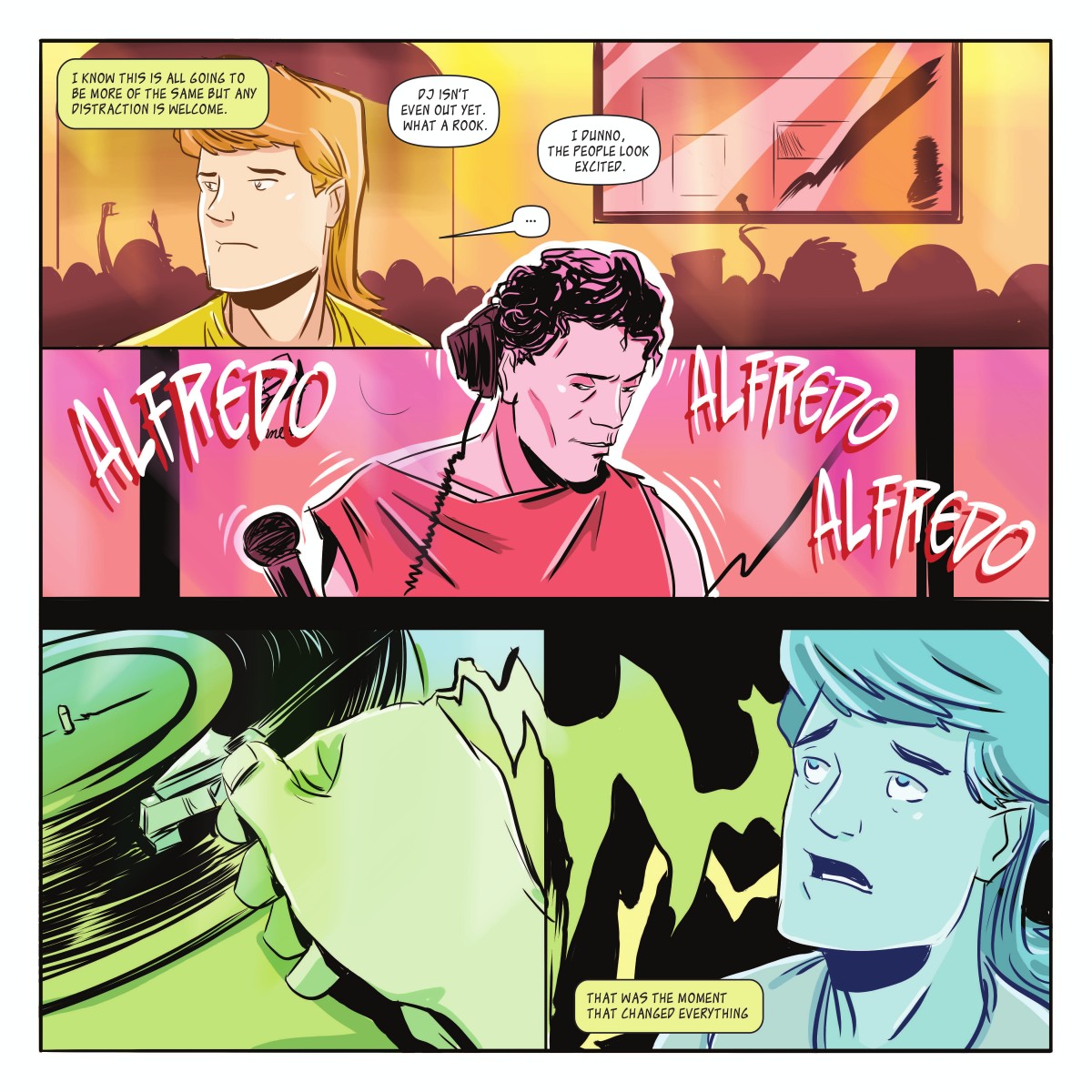
Comic Crusaders: There are a couple of pages in part one of the story where Paul and his friends are at the club, and the world around him seems to go black. The pages are beautiful. Was this an idea that the script called for, or did it come from inside you as a way to describe how Paul was feeling at the time?
Chris Hunt: We were given a very large degree of freedom on this to interpret and even build out the story to some extent on our side, so that was all a stylistic choice I made going into that scene. I“ve never been to a rave, let alone Ibiza but I have been at shows in venues where it“s not a stadium, and it“s not a lounge-it“s just big enough that it“s past the point of intimate but you feel like you“re sharing the same energy with everyone in the room. That can be powerful for a creative in my opinion, and I have had sort of existential moments in such circumstances where I“ve felt very much alone in a packed room because of the baggage I brought in with me, good or bad. In fact, I have felt more alone, and more an individual in this sort of setting than I could ever in a room truly alone. You feel like the rock with which the waves are crashing around. It“s a very strange feeling, and to me when I read the script, knowing that this was a moment in Paul“s life where he made a very deliberate choice to go a different path, given everything that had led up to it, I wanted to try to imbue my experiences into it in that way.
Comic Crusaders: In graphic novels, the art really brings out the mood of the story. As Paul was getting the idea to build the Perfecto world, it“s as if you can feel his heart jumping from the page. Can you describe what your process was like as an artist to bring about the shift in moods after the tragic events that occurred shortly before?
 Chris Hunt: My book CARVER was a direct result of losing two of my closest friends months apart from one another at a time when my career was on the rise. I was young, in my mid 20“s and it completely railroaded me for a couple of years as I struggled to make sense of things-of myself really because I had changed irrevocably and suddenly because of it. I changed basically overnight to be honest, it just took a bit to turn it into something. So with the moment in the book to which you“re referring, I tried to remember what my moment was like; the before and the after. Of having direction and drive, but then being confronted by the brutal truth of living and then having to decide how to proceed. I have a vivid memory from amidst those months where one of the two friends, Loren Reed, was on a morphine drip at his parent“s home dying of cancer and I was at a Black Angels concert in Boise with friends. I was trying to escape from myself and circumstances, just for a couple of hours, and it worked more or less, once I laid back into the music and just let it carry me. That“s really the last scene for me in my part, where Paul and his friends make it to Ku and he“s the last one to let go as the camera pulls back. He (we) are letting ourselves be apart of something bigger in that moment.
Chris Hunt: My book CARVER was a direct result of losing two of my closest friends months apart from one another at a time when my career was on the rise. I was young, in my mid 20“s and it completely railroaded me for a couple of years as I struggled to make sense of things-of myself really because I had changed irrevocably and suddenly because of it. I changed basically overnight to be honest, it just took a bit to turn it into something. So with the moment in the book to which you“re referring, I tried to remember what my moment was like; the before and the after. Of having direction and drive, but then being confronted by the brutal truth of living and then having to decide how to proceed. I have a vivid memory from amidst those months where one of the two friends, Loren Reed, was on a morphine drip at his parent“s home dying of cancer and I was at a Black Angels concert in Boise with friends. I was trying to escape from myself and circumstances, just for a couple of hours, and it worked more or less, once I laid back into the music and just let it carry me. That“s really the last scene for me in my part, where Paul and his friends make it to Ku and he“s the last one to let go as the camera pulls back. He (we) are letting ourselves be apart of something bigger in that moment.
Comic Crusaders: How fun was it to draw Paul with such an amazing mullet? What did he think of your rendering of him?
Chris Hunt: There really wasn“t any discussion about “The Mullet”“ (hahaha). I just saw from the reference material that he was rocking a mullet in the day, and thought to myself, “Oh this is happening.”“ I kept waiting for something to be said, but no one ever did. Once I committed to the mullet, I really tried to research club clothes from that time and particularly in and around the trance movement, which is why you“ll see some characters with smiley face shirts, and decidedly late 80“s fashion.
Comic Crusaders: Would you be able to share some insight into what it was like working with one of the most celebrated electronic music artists for more than a generation? How did he respond to your ideas about how to lay out the pages?
 Chris Hunt: When I“ve worked on projects that involve musicians or actors, there“s typically a lot of back and forth about the minutiae- the stuff that to be honest, doesn“t really matter. It“s more to assuage egos. The whole creative process was actually very laissez-faire, and wholly unexpected on my part. So from the get go, that took a lot of pressure off and I think speaks volumes to the kind of human being, Paul is.
Chris Hunt: When I“ve worked on projects that involve musicians or actors, there“s typically a lot of back and forth about the minutiae- the stuff that to be honest, doesn“t really matter. It“s more to assuage egos. The whole creative process was actually very laissez-faire, and wholly unexpected on my part. So from the get go, that took a lot of pressure off and I think speaks volumes to the kind of human being, Paul is.
On a purely personal level, it was very cool. Through High School, I was heavily involved with digital video which was really at the nascent stage for consumers then. My entire friend group revolved around writing, and producing shorts for school as well as our own edification and as a result we“d often bite off more than we could chew, so we“d be working through the weekends until 2-3am, working in shifts. It was actually the foundation for my professional career, and for the guys I was doing this stuff with as well who also have gone on to have careers in creative spaces. We treated it like a job. On those late weekend nights, we“d be at my friend Kyle Kirchhoff“s house and when we were dragging around 1am, he“d turn on this mix. The room would be dark, save for light from the monitors and the glow of blue leds on his hardware, and we“d sit and edit to that mix, which was actually Paul“s “Tranceport”“ from 1998. So to be working on a book with Paul 15 years later was a real trip, but incredibly galvanizing.
Comic Crusaders: This book lets readers in on the tremendous relationship between Paul and his parents. What, if any, special direction did you receive for the panels where he was with them? The love seems like it was easy to capture
Chris Hunt: Again, despite the obvious importance of that relationship, all four of us who were the artists on the book were allowed to interpret that in our own ways. So I approached it as me talking to my parents, especially my mom, Beth Sweig, who“s unshakable faith in me has carried me to this point in my life. She“s been there when I didn“t believe in myself, and she stuck by me when frankly, I could have been a better son-yet she never waivered. To me I felt that in Paul“s relationship as I was reading the script, and just tried to infuse my emotional recall from my own experiences into it.
I would like to thank Chris Hunt for taking the time to answer some questions about his work on this project. Paul Oakenfold’s passion for music and his parents really shone through on the pages and this would not have been possible without the four great artist who added their talent to the mix. When my two passions, music and comics, blend together so well, I feel it is my duty to make sure everyone knows about it.
Get your copy HERE
Follow Paul on Soundcloud:Â https://soundcloud.com/pauloakenfold
Author Profile
- In his free time, other than reading comic books, Bryan enjoys listening to his ever growing record collection and driving his 27 year old roadster named Mingo.
Latest entries
 Comic BooksMarch 27, 2019Review: Neon Future #1
Comic BooksMarch 27, 2019Review: Neon Future #1 Comic BooksJanuary 21, 2019Review: Chaotic Flux #1
Comic BooksJanuary 21, 2019Review: Chaotic Flux #1 Comic BooksNovember 20, 2018Review: After Houdini
Comic BooksNovember 20, 2018Review: After Houdini Comic BooksSeptember 26, 2018Advance Review: Stranger Things #1
Comic BooksSeptember 26, 2018Advance Review: Stranger Things #1

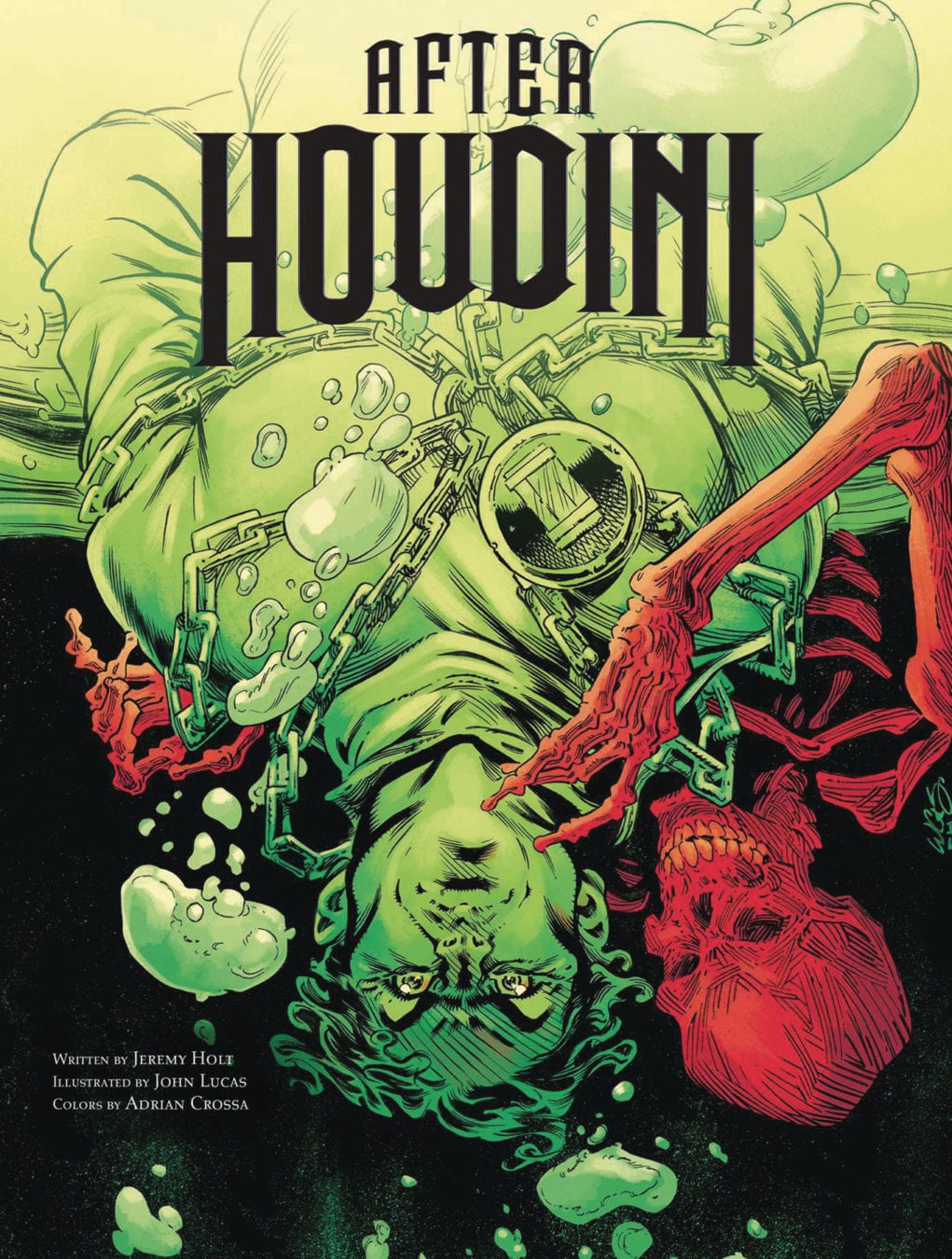


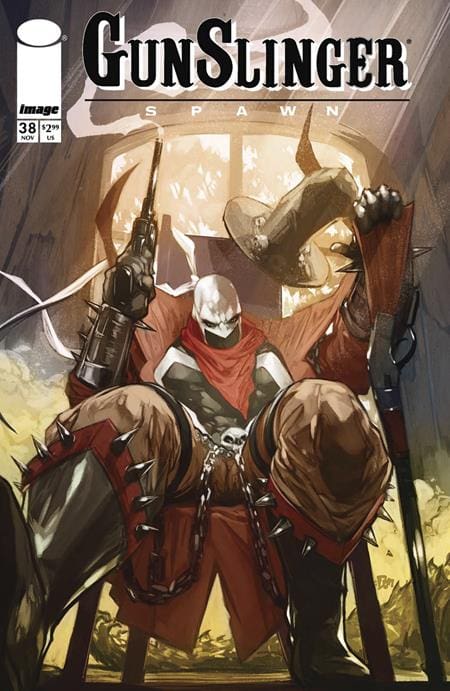
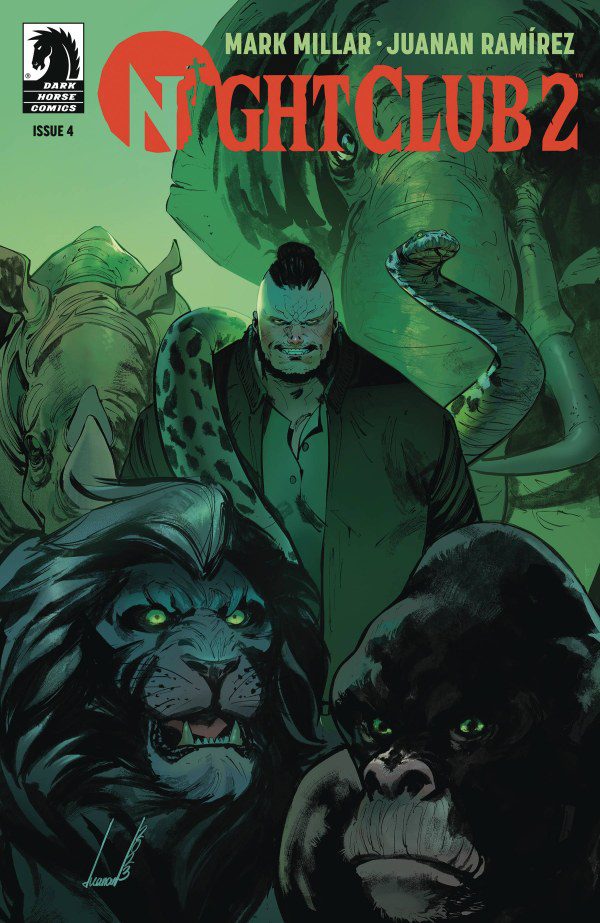


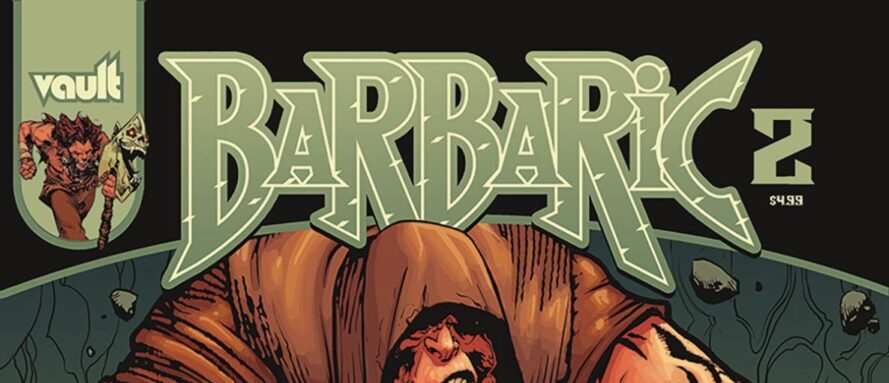
You must be logged in to post a comment.